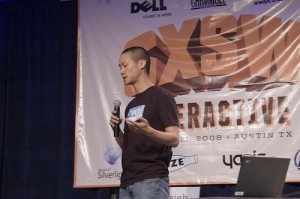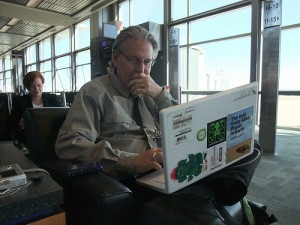Presentation Tips: More from Lawrence Lessig
I posted back in March about Lawrence Lessig’s “Keynote Ballet.” Lessig gives beautiful presentations. He uses simple slides in a way that illustrates his points without boring his audience. I occasionally find myself counseling clients to skip bullet-heavy PowerPoint decks in favor of an approach similar to Lessig. Please take a moment to watch this presentation – even if it’s just the first minute or two. You’ll get the idea.
Stuff You Should Know
 I’ve recently added a new podcast to my roster. Stuff You Should Know is brought to you by Josh Clark and Chuck Bryant from How Stuff Works. The boys give you the lowdown on such subjects as the evils of high fructose corn syrup and how face transplants work. Clever and geeky, funny and well-read, Josh and Chuck educate while demonstrating a love for language and stats. Averaging about 20 minutes, episodes are great content for killing time while running errands or driving to the office.
I’ve recently added a new podcast to my roster. Stuff You Should Know is brought to you by Josh Clark and Chuck Bryant from How Stuff Works. The boys give you the lowdown on such subjects as the evils of high fructose corn syrup and how face transplants work. Clever and geeky, funny and well-read, Josh and Chuck educate while demonstrating a love for language and stats. Averaging about 20 minutes, episodes are great content for killing time while running errands or driving to the office.
Listen via iTunes or via your podcatcher of choice.
Root Canals – Some Practical Advice
I recently needed to have a root canal. My first reaction, of course, was fear. “Root canal” has become the poster-child for All Things Painful and Bad. Turns out, it wasn’t really that bad. It’s about as invasive as getting a filling – it just takes longer. The Novocaine shot is really the only part that hurts. Here are some tips if you find yourself in the same situation:
Before the Root Canal
- Don’t waste any time: An abscess (a bad infection inside your tooth) reduces the pH of the surrounding tissue. This impedes the effectiveness of local anesthetics (like Novocaine). When you hear a horror story about a root canal, it’s probably because the tooth was really infected by the time they made it to the doctor.
- Don’t drink alcohol: This might just be me, but having a drink just made my tooth hurt worse. I attributed it to increased blood flow to my head. Who knows. Regardless, having a drink seemed to make things a lot worse.
- Treat the pain: I’m not a doctor. Let’s be clear on that. I did, however, find some things that helped with the pain:
- Take more Ibuprofen: Again – I’m not a doctor! But you can probably take more Ibuprofen than is indicated on the packaging. I found that I needed to keep a written log, though, of what I took and when. A toothache has a way of making you stop thinking rationally.
- ‘Swish’ with rum: Although I don’t recommend drinking alcohol when you have a toothache, I did find that swishing some booze around in my mouth did an OK job of acting as a local aesthetic. This might be placebo, but it helped me. Orajel did absolutely nothing for me. The pain is inside the tooth. Seems like if the rum worked that the Orajel should. Not in my case.
- Keep the head elevated: When you sleep, use an extra pillow. Too much blood to the head = painful throb = no sleep.
During/After the Root Canal
- Find a dentist/hygenist that you like: You’re going to have to listen to the dentist and their assistant make small talk for about two hours. If your dentist is a jerk, this is just gonna make things worse. It doesn’t hurt if the dentist/hygenist is cute.
- Pack your iPod with tunes: plan on going to your happy place. Your dentist may be irritated that they have to nudge you every time they need to talk to you, but screw it – it’s your mouth we’re talking about here. They’ll get over it. Be sure you can work the pause or volume with one hand so that you can stop the music when they do need to talk to you, though.
- Take it easy for a day: You just got a root canal. Your boss will cut you some slack. “Root canal” has magical properties. Stay home and watch TV all day.
So long, Joe
I was saddened to see Joe Miller’s name among those laid off by the N&O this week. I’ve long been a fan of his Take It Outside column. Holly and I had the pleasure of riding with Joe for a few miles during the inaugural Cycle NC back in ’99. Joe’s a friendly guy with a heart for outdoor recreation. I wish him well.
#SXSW2009 – Tony Hsieh, Zappos.com
 photo by Roustem Karimov
photo by Roustem Karimov
Zappos CEO Tony Hsieh (pronounced “shay”) is a smart, friendly guy. In 1994 he started a business selling pizzas. Today, Zappos sells upwards of a billion dollars worth of shoes per year. Tony attributes much of Zappos success to one core element: company culture. Every Zappos employee, from the stock-room to the board-room, understands the company culture and it’s primary tennant: awesome customer service.
The slides from Tony’s SXSW presentation are here.
Some nuggets from Tony:
- People may not remember what you did or said, but they’ll remember how you made them feel.
- It doesn’t matter what your core values are, but that you commit to them. Alignment is key.
- Perceived control and perceived progress make people happier. An example: Zappos has a 3-year process in place for employees to reach a certain job position. They broke the process into 3 smaller segments. The only difference being that the interstitial steps have names. Employee satisfaction improves.
- During the hiring process, prospective employees are asked “How lucky are you?” The answer to this question gives insight into how that person perceives the world and their life.
- After completing initial training, new Zappos employees are offered $2000 to quit. Very few take the cash-out. The folks that remain have given more thought to “Do I want to be here?” and Zappos avoids losing hiring/training costs of people that don’t stick around. Tony says “Not enough people are taking the money. We may have to increase the amount.”
#SXSW2009 – Lawrence Lessig, Change v2.0

photo by Joel Housman
Lawrence Lessig is known for his focus on technology and law, especially as it applies to copyrights. A couple of years ago, he announced his intention to change his focus from copyright matters to political corruption. Earlier this year, he helped launch Change Congress, a web based project aimed at educating people about the influence of money in the political system.
Consider any public office where it’s known that a politician has accepted donations from a special interest group. We immediately assume that there is a money-for-influence scheme at work here, regardless of how “good” we perceive this politician to be. We assume that this politician abandons personal convictions when presented with a check. Sure, this isn’t a groundbreaking observation, but it’s time we fixed things and removed this taint from the system. Money corrupts democracy.
Change Congress’ immediate concern is H.R. 801, sponsored by John Conyers. This proposal forbids the government from requiring scientists who receive taxpayer funds for medical research to publish their findings openly on the Internet. Government-funded (our tax dollars) research would be available solely via for-profit journals inaccessible by the general public. Maplight.org reports that Conyers is receiving disproportionate donations from the benefiting publishing interests.
In a semi-related note, Lessig really knows how to deliver a presentation. I’ve been referring to it as “Keynote ballet”. His timing is excellent, his slides are interesting and there’s not a bullet point in sight. Beautiful.
About the title: using # symbols is a trend that’s recently caught on in Twitter. It allows people to tag the context of their discussion. Use of these “hash tags” is hotly debated, but apppears to be here to stay. This post is inspired by panels I attended at SXSW Interactive 2009.
#SXSW2009 – Bruce Sterling
photo by Scott Beale / Laughing Squid
I spent the last week at SXSW Interactive 2009 in Austin, TX. This was my second time attending. I’m still unpacking, physically and metaphorically, and I plan to post some thoughts and reactions over the next couple of days.
About the title: using # symbols is a trend that’s recently caught on in Twitter. It allows people to tag the context of their discussion. Use of these “hash tags” is hotly debated, but apppears to be here to stay.
I’ll start with the one of the sessions that I’ve been thinking about a lot these last couple of days. Author, journalist, futurist and “global microbrand” Bruce Sterling delivered his much-anticipated rant to a packed crowd. Bruce chastised us all for not doing enough. We’re all tweeting when we should be listening. We’re letting good art and good stories (and good publishers!) die by our inattention.
My takeaway from the session is this: I’m going to create more (things! not just digital artifacts). I’m going to try to be a better audience member and participant. I’m going to focus more on engaging people in conversation than just getting my point across. To quote Mr. Sterling: “Let’s talk about our relationship. Yours and mine.”
